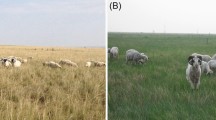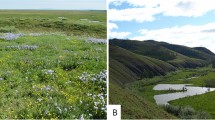Abstract
Small herbivores play keystone functional roles in grassland ecosystems. Recognising the combined effects where herbivores co-exist is important for guiding grassland restoration and biodiversity conservation. On the Tibetan Plateau, both plateau pikas and Himalayan marmots are regarded as pests by Tibetan people and local government, but little is known about their combined effects. We conducted a field study to determine the combined effects of pikas and marmots on plant biodiversity and vegetation structure. Plateau pikas alone consistently reduced the plant height and diversity and increased the vegetation cover of physically unpalatable plants. However, the co-existence of marmots with pikas decreased the vegetation cover of physically unpalatable plants, while increasing the cover of palatable plants and plant diversity, ultimately changing the impact of pikas alone and modulating aspects of the plant community. These results illustrate that increasing the abundance and richness of small herbivores in grassland ecosystems may promote plant diversity and benefit vegetation restoration rather than aggravate the degradation of grasslands.





Similar content being viewed by others
References
Alba-Lynn C, Detling J (2008) Interactive disturbance effects of two disparate ecosystem engineers in North American shortgrass steppe. Oecologia 157:269–278
Bagchi S, Namgail T, Ritchie ME (2006) Small mammalian herbivores as mediators of plant community dynamics in the high-altitude arid rangelands of Trans-Himalaya. Biol Conserv 127:438–442
Ceballos G, Ehrlich PR (2002) Mammal population losses and the extinction crisis. Science 296:904–907
Collins SL, Smith MD (2006) Scale-dependent interaction of fire and grazing on community heterogeneity in tallgrass prairie. Ecology 87:2058–2067
Davidson AD, Lightfoot DC (2006) Keystone rodent interactions: prairie dogs and kangaroo rats structure the biotic composition of a desertified grassland. Ecography 29:755–765
Davidson AD, Ponce E, Lightfoot DC, Fredrickson EL, Brown JH, Cruzado J, Brantley SL, Sierra-Corona R, List R, Toledo D, Ceballos G (2010) Rapid response of a grassland ecosystem to an experimental manipulation of a keystone rodent and domestic livestock. Ecology 91:3189–3200
Davidson AD, Detling JK, Brown JH (2012) Ecological roles and conservation challenges of social, burrowing, herbivorous mammals in the world’s grasslands. Front Ecol Environ 10:477–486
DeGabriel JL, Albon SD, Fielding DA, Riach DJ, Westaway S, Irvine RJ (2011) The presence of sheep leads to increases in plant diversity and reductions in the impact of deer on heather. J Appl Ecol 48:1269–1277
Díaz S, Lavorel S, McIntyre SUE et al (2007) Plant trait responses to grazing—a global synthesis. Glob Change Biol 13:313–341
Dobson FS, Smith AT, Wang XG (1998) Social and ecological influences on dispersal and philopatry in the plateau pika (Ochotona curzoniae). Behav Ecol 9:622–635
du Toit JT (2011) Coexisting with cattle. Science 333:1710–1711
Fan N, Zhou W, Wei W, Wang Q, Jiang Y (1999) Rodent pest management in the Qinghai–Tibet alpine meadow ecosystem. In: Singleton G, Hinds L, Leirs H, Zhang ZB (eds) Ecologically-based rodent management. Australian Centre for International Agricultural Research, Canberra, pp 285–304
Gao M, Li X, Cao C, Zhang H, Li Q, Zhou H, He Q, Xu M, Zhao J, Zheng S, Chen W (2010) Spatial prediction and analysis of Himalayan marmot plague natural epidemic foci in China based on HJ-1 satellite data. Sci China Earth Sci 53:8–15
Guo ZG, Li XF, Liu XY, Zhou XR (2012a) Response of alpine meadow communities to burrow density changes of plateau pika (Ochotona curzoniae) in the Qinghai–Tibet Plateau. Acta Ecol Sin 32:44–49
Guo ZG, Zhou XR, Hou Y (2012b) Effect of available burrow densities of plateau pika (Ochotona curzoniae) on soil physicochemical property of the bare land and vegetation land in the Qinghai–Tibetan Plateau. Acta Ecol Sin 32:104–110
Hill MO, Gauch JHG (1980) Detrended correspondence analysis: an improved ordination technique. Vegetatio 42:47–58
Hogan BW (2010) The plateau pika: a keystone engineer on the Tibetan Plateau. Dissertation, Arizona State University
Huenneke LF, Clason D, Muldavin E (2001) Spatial heterogeneity in Chihuahuan Desert vegetation: implications for sampling methods in semi-arid ecosystems. J Arid Environ 47:257–270
Huntly N, Reichman OJ (1994) Effects of subterranean mammalian herbivores on vegetation. J Mammal 75:852–859
Jiang ZG, Xia WP (1985) Utilization of the food resources by plateau pika. Acta Theriol Sin 5:251–262
Jiang ZY, Li JZ, Xi RRD, Zha X, Ge L (2009) The ecology study on Marmota Himalayan of the Qinghai–Tibet railway. Chin J Control Endem Dis 24:321–323
Limbach WE, Davis JB, Bao T, Shi D, Wang C (2000) The introduction of sustainable development practices of the Qinghai livestock development project. In: Zheng D (ed) Formation and evolution, environmental changes and sustainable development on the Tibetan Plateau. Academy Press, Beijing, pp 509–522
Marion B, Bonis A, Bouzillé JB (2010) How much does grazing-induced heterogeneity impact plant diversity in wet grasslands? Ecoscience 17:229–239
Nikol’skii A, Ulak A (2006) Key factors determining the ecological niche of the Himalayan marmot, Marmota himalayana, Hodgson (1841). Russ J Ecol 37:46–52
Odadi WO, Karachi MK, Abdulrazak SA, Young TP (2011) African wild ungulates compete with or facilitate cattle depending on season. Science 333:1753–1755
Olff H, Ritchie ME (1998) Effects of herbivores on grassland plant diversity. Trends Ecol Evol 13:261–265
Poudel BS, Spooner PG, Matthews A (2015) Temporal shift in activity patterns of Himalayan marmots in relation to pastoralism. Behav Ecol. doi:10.1093/beheco/arv083
Qu J, Li K, Yang M, Li W, Zhang Y, Smith AT (2007) Seasonal dynamic pattern of spacial territory in social groups of plateau pikas (Ochotona curzoniae). Acta Theriol Sin 27:215–220
Qu J, Li W, Yang M, Ji W, Zhang Y (2013) Life history of the plateau pika (Ochotona curzoniae) in alpine meadows of the Tibetan Plateau. Mamm Biol 78:68–72
R Development Core Team (2012) R: a language and environment for statistical computing. R Foundation for Statistical Computing, Vienna, Austria. http://www.r-project.org/
Retzer V (2007) Forage competition between livestock and Mongolian Pika (Ochotona pallasi) in Southern Mongolian mountain steppes. Basic Appl Ecol 8:147–157
Rueda M, Rebollo S, García-Salgado G (2013) Contrasting impacts of different-sized herbivores on species richness of Mediterranean annual pastures differing in primary productivity. Oecologia 172:449–459
Schipper J, Chanson JS, Chiozza F et al (2008) The status of the world’s land and marine mammals: diversity, threat, and knowledge. Science 322:225–230
Semenov Y, Ramousse R, Berre ML, Tutukarov Y (2001) Impact of the black-capped marmot (Marmota camtschatica bungei) on floristic diversity of arctic tundra in northern Siberia. Arct Antarct Alp Res 33:204–210
Smith AT, Foggin JM (1999) The plateau pika (Ochotona curzoniae) is a keystone species for biodiversity on the Tibetan Plateau. Anim Conserv 2:235–240
Smith AT, Xie Y (2008) A guide to the mammals of China. Princeton University Press, Princeton
Su J, Liu J (2000) Overwinter of small herbivorous mammals inhabiting alpine area. Acta Theriol Sin 20:186–192
Suzuki R, Suzuki S (2012) Morphological adaptation of a palatable plant to long-term grazing can shift interactions with an unpalatable plant from facilitative to competitive. Plant Ecol 213:175–183
Wang C, Wang Q, Long R, Jing Z, Shi H (2004) Changes in plant species diversity and productivity along an elevation gradient in an alpine meadow. Acta Phytoecol Sin 28:240–245
Xin H (2008) A green fervor sweeps the Qinghai–Tibetan Plateau. Science 321:633–635
Xu C, Yu X (2011) Cause of alpine grassland degradation and its restoration strategy in Tianzhu County. Prata Sci 28:1695–1699
Xu X, Chen H, Jason KL (2008) Spatiotemporal vegetation cover variations in the Qinghai–Tibet Plateau under global climate change. Chin Sci Bull 53:915–922
Yoshihara Y, Ohkuro T, Bayarbaatar B, Takeuchi K (2009) Effects of disturbance by Siberian marmots (Marmota sibirica) on spatial heterogeneity of vegetation at multiple spatial scales. Grassl Sci 55:89–95
Yoshihara Y, Okuro T, Buuveibaatar B, Undarmaa J, Takeuchi K (2010a) Complementary effects of disturbance by livestock and marmots on the spatial heterogeneity of vegetation and soil in a Mongolian steppe ecosystem. Agric Ecosyst Environ 135:155–159
Yoshihara Y, Okuro T, Buuveibaatar B, Undarmaa J, Takeuchi K (2010b) Responses of vegetation to soil disturbance by Siberian marmots within a landscape and between landscape positions in Hustai National Park, Mongolia. Grassl Sci 56:42–50
Acknowledgments
This study was supported by the National Natural Science Foundation of China (31300320, 31270467), the Chinese Academy of Sciences Fellowship for Young International Scientists to J.C.R., Key Technology Research and Development Program of Qinghai Province (2014-NS-113). Thank you to the reviewers and editors for comments which improved the quality of the manuscript.
Author information
Authors and Affiliations
Corresponding author
Ethics declarations
Conflict of interests
Authors have declared no conflict of interests.
Additional information
Communicated by Karen E. Hodges.
This research was conducted in a manner that complies with current Chinese laws.
Electronic supplementary material
Below is the link to the electronic supplementary material.
Rights and permissions
About this article
Cite this article
Qu, J., Ji, W., Russell, J.C. et al. The more the merrier? Multi-species grazing of small herbivores mediates plant community impacts. Biodivers Conserv 25, 2055–2069 (2016). https://doi.org/10.1007/s10531-016-1178-7
Received:
Revised:
Accepted:
Published:
Issue Date:
DOI: https://doi.org/10.1007/s10531-016-1178-7




